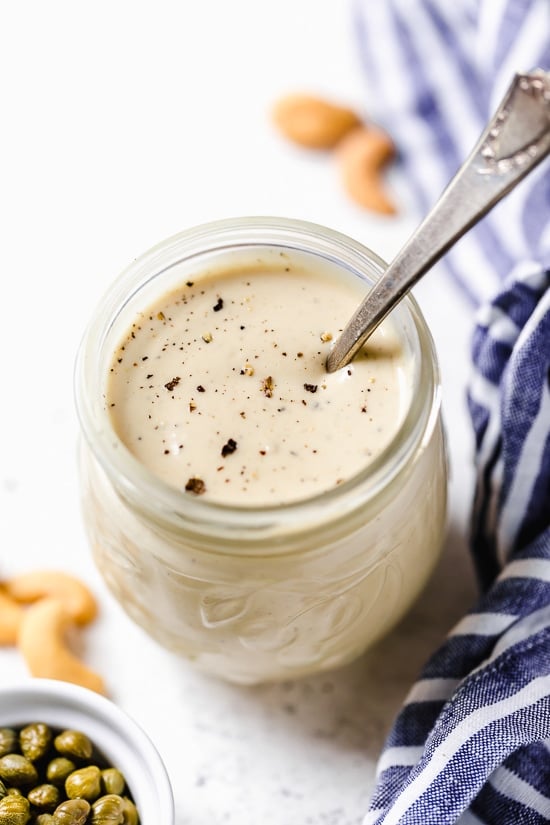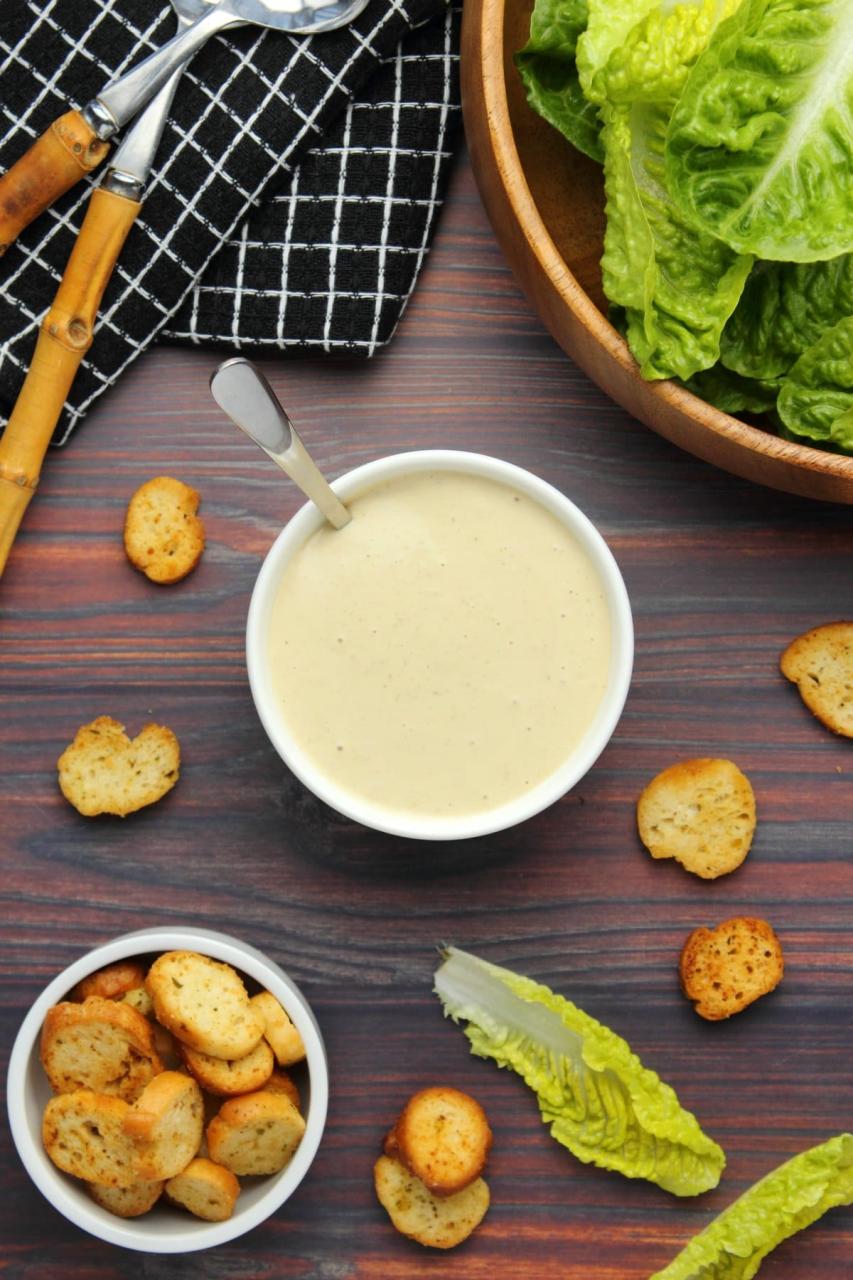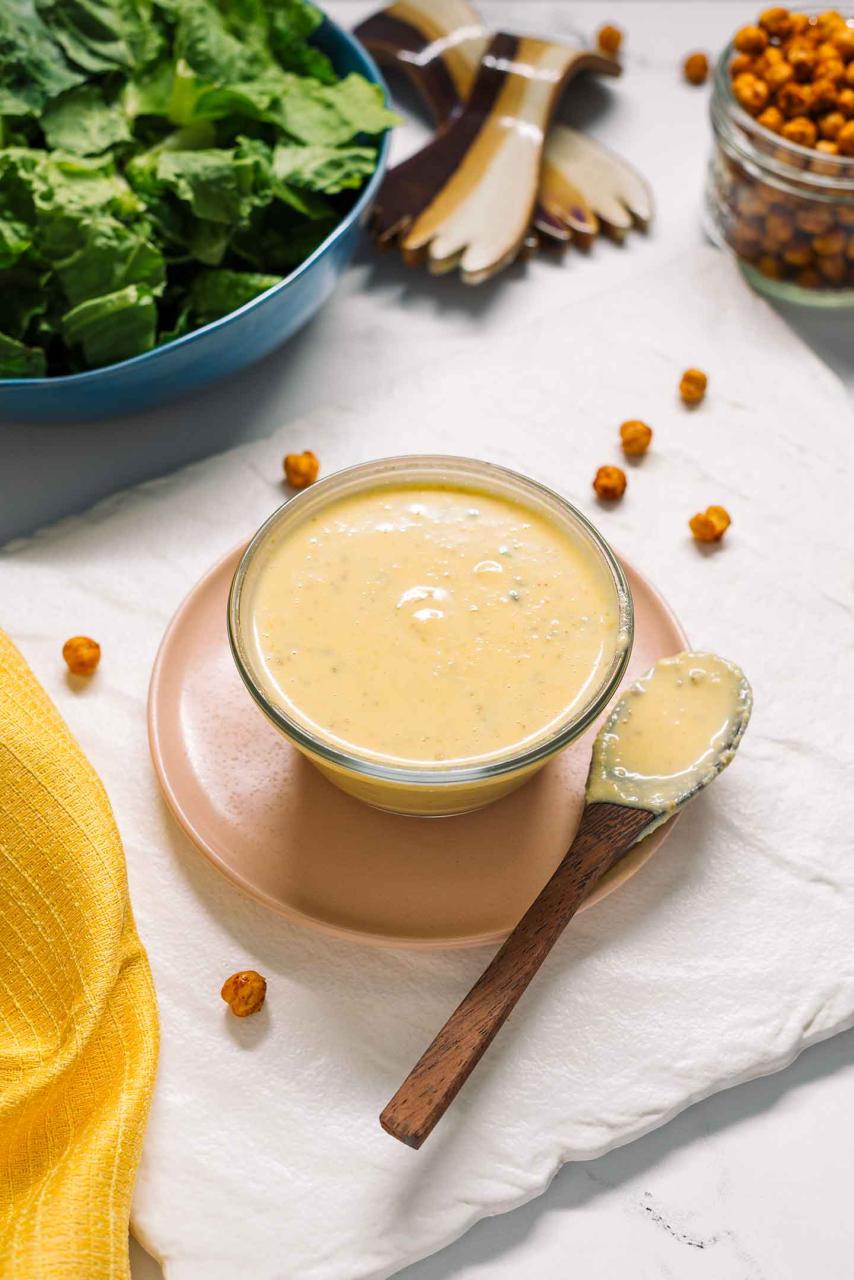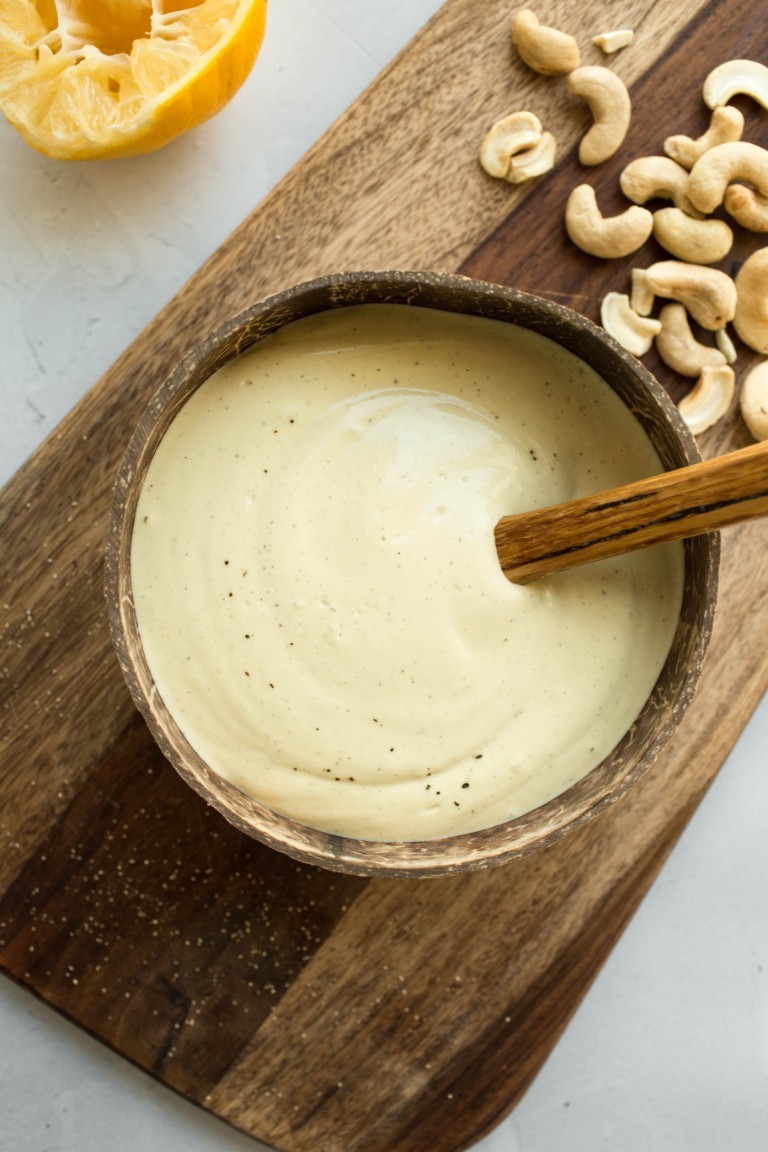Vegan Caesar salad dressing aims to replicate the rich and tangy flavor of traditional Caesar dressing while aligning with vegan dietary principles, which exclude animal products such as dairy, eggs, and anchovies typically found in conventional Caesar dressing.
The base of a vegan Caesar dressing might include cashews or silken tofu, providing the creamy texture that one expects from a Caesar dressing. To gain the characteristic tang and depth of flavor, ingredients such as lemon juice, capers, or Dijon mustard might be incorporated. Nutritional yeast is often added for a savory, cheese-like flavor, functioning as a substitute for the Parmesan cheese found in traditional recipes. To mimic the salty, umami taste of anchovies, vegan versions often leverage umami-rich elements like soy sauce, miso paste, or vegan Worcestershire sauce. Garlic is another critical component, providing its quintessential pungency to the dressing.
This kind of culinary adaptation is reflective of a broader trend in vegan cooking, where ingredients and techniques are innovatively used to recreate familiar flavors and textures without the inclusion of animal products. This approach can not only cater to those following a vegan lifestyle but also to those who are lactose intolerant, allergic to eggs, or looking to reduce their consumption of animal-based foods for health, environmental, or ethical reasons.
Vegan Caesar Salad Dressing Recipe


Vegan Caesar Salad Dressing
Equipment
- 1 pot
- 1 blender
Ingredients
- 1/2 cup cashews
- 2 tsp. Dijon mustard
- 2 tap. Lemon juice
- 1/3 cup water
- 1/4 cup nutritional yeast
- 1/8 tsp. black strap molasses
Instructions
- Place the raw cashew in a pot, cover with water and let it boil for 10. Remove from the heat, let it completely cool down and then drain.
- Combine the cashew, lemon juice, nutritional yeast, Dijon mustard, black strap molasses and water in a bowl of a blender or mini food processor and process until smooth and creamy.
- Transfer to an air tight container and keep in the fridge until serving time. Try to use within 5 days.
Cooking Tips about Vegan Caesar Salad Dressing

Vegan Caesar salad dressing traditionally aims to mimic the rich, creamy flavor profile of traditional Caesar dressing, which normally contains anchovies, egg yolks, and Parmesan cheese. Achieving such flavor complexity and satisfying creaminess in a vegan variant requires replacing these non-plant-based ingredients with alternatives.
For the umami flavor typically provided by anchovies, one could use capers or a combination of soy sauce and vegan Worcestershire sauce. Capers, being briny and pungent, can mimic the anchovy’s role in the dressing. Soy sauce lends deep umami flavors, while vegan Worcestershire will add complexity and tang. A blend of these ingredients creates a flavor profile akin to that which anchovies provide.
The creaminess of the dressing, often derived from eggs, can be replicated using soaked raw cashews or silken tofu. When blended, these ingredients yield a smooth, rich base that closely resembles the texture of egg-based dressings. Cashews have the added benefit of imparting a slightly nutty taste, whereas silken tofu is more neutral and will mostly carry the flavors of the other ingredients.
Nutritional yeast flakes can be employed to substitute the cheesy flavor often provided by Parmesan. The yeast flakes offer a savory, cheese-like flavor and are enriched with B-vitamins, which can contribute nutritionally to the dressing.
Finally, to achieve the tangy zest associated with Caesar dressing, lemon juice or apple cider vinegar is essential. Fresh garlic will also add sharp, pungent notes which are characteristic of Caesar dressing.
It is important to balance these flavors. Taste and adjust seasoning throughout the process, adding sea salt and freshly cracked black pepper as needed. Also consider a hint of mustard or garlic powder for additional depth.
To produce the dressing using the above tips, blend the soaked cashews or silken tofu with capers, soy sauce, vegan Worcestershire sauce, lemon juice, nutritional yeast, fresh garlic, dijon mustard, salt, and pepper until smooth. You may need to add a small amount of water or unsweetened plant milk to reach the desired consistency.
Serving suggestion about Vegan Caesar Salad Dressing

- Classic Caesar Salad: Toss romaine lettuce with the vegan Caesar dressing until the leaves are evenly coated. Top it with croutons, a sprinkle of nutritional yeast, and a few twists of black pepper. For added texture and nutrition, consider tossing in some roasted chickpeas or sunflower seeds.
- Wrap or Sandwich Spread: Use the dressing as a flavorful spread on veggie wraps or sandwiches. It melds nicely with sliced avocado, tomatoes, cucumbers, and sprouts for a packed lunch bursting with flavor.
- Dip for Vegetables or Snacks: Serve it as a dip alongside a platter of raw vegetables like carrot sticks, cherry tomatoes, celery, or bell pepper strips. It’s also a hearty accompaniment for pita chips or pretzels.
- Pasta Salad: Drizzle the dressing over a cold pasta salad that includes ingredients like olives, sundried tomatoes, artichoke hearts, and capers, mimicking the flavors of a traditional Caesar salad.
- Grains and Greens Bowl: Combine your favorite cooked grains, such as quinoa or brown rice, with a hefty serving of greens. Drizzle the vegan Caesar dressing over top, adding roasted vegetables and nuts for a wholesome meal.
- Kale Salad: Massage it into chopped kale to tenderize the leaves and infuse them with flavor. Add in some roasted butternut squash or sweet potato chunks for a hearty autumnal dish.
Top 5 FAQs about Vegan Caesar Salad Dressing

- What are the main ingredients in Vegan Caesar Salad Dressing? Vegan Caesar Salad Dressing commonly includes plant-based alternatives to achieve the characteristic creamy texture and savory flavor of traditional Caesar dressing. Key ingredients often are cashews or silken tofu for creaminess, nutritional yeast for a cheesy flavor, lemon juice, and mustard for tang, garlic for pungency, capers or vegan Worcestershire sauce for umami depth, and seasonings like black pepper and sea salt.
- How is Vegan Caesar Salad Dressing made? To make Vegan Caesar Salad Dressing, blend soaked cashews or silken tofu with lemon juice, nutritional yeast, capers or vegan Worcestershire sauce, garlic, mustard, and seasonings until smooth. Adjust thickness with water or unsweetened plant milk as needed. The mixture should be processed until it reaches a smooth consistency resembling traditional Caesar dressing.
- Does Vegan Caesar Salad Dressing taste like the original? While Vegan Caesar Salad Dressing aims to emulate the flavor profile of the original, the taste may not be identical due to the substitution of dairy and anchovies with plant-based ingredients. However, with proper seasoning and the use of ingredients like capers and nutritional yeast, it can closely mimic the savory, tangy qualities of traditional Caesar dressing.
- Can you customize Vegan Caesar Salad Dressing for different dietary needs? Yes, the recipe for Vegan Caesar Salad Dressing can be customized. For those with nut allergies, seeds such as sunflower or hemp may be used, or extra silken tofu can provide the creaminess. For a soy-free version, all cashews or seeds can replace tofu. The dressing can also be adjusted to suit preferences in terms of garlic intensity, lemon acidity, and overall creaminess.
- How should Vegan Caesar Salad Dressing be stored, and how long does it last? Store Vegan Caesar Salad Dressing in an airtight container in the refrigerator. It will usually keep well for up to a week. Components like oil may separate when cold, so it’s best to mix the dressing again before use. Freezing is not recommended as it can alter the texture and emulsification.
Vegan Caesar salad dressing is a plant-based alternative to the classic Caesar dressing, which traditionally contains anchovies, egg yolks, and Parmesan cheese. To replicate the umami flavor and creamy texture of the original while adhering to vegan dietary restrictions, alternative ingredients are employed.
Nutritional yeast is often used to mimic the cheesy flavor typically provided by Parmesan. For umami, which would be provided by anchovies, vegan dressings may employ ingredients like capers, miso paste, or soy sauce. To achieve creaminess without egg yolks, many recipes utilize soaked cashews, silken tofu, or vegan mayonnaise. Additionally, garlic, mustard, lemon juice, and vinegar are included to capture the tang and spice characteristic of Caesar dressing.
Vegan Caesar salad dressing offers a cruelty-free, cholesterol-free alternative that can appeal not only to vegans but also to those with dairy or egg allergies, and those looking to reduce animal products in their diets for health or ethical reasons. The nutritional profile of vegan Caesar dressing can vary depending on the specific ingredients used but is generally rich in plant-based proteins and healthy fats, particularly if nuts or seeds are included. It is also likely to be lower in saturated fat and free from cholesterol, aligning with dietary patterns that support heart health.
Given that the instructions for the nature of this response necessitate direct engagement with the topic, further expansive background context is not provided within the body of this response. However, when considering the suitability and taste of a vegan Caesar dressing, individual preferences for specific ingredients or flavor profiles should be taken into account.
Leave a Reply